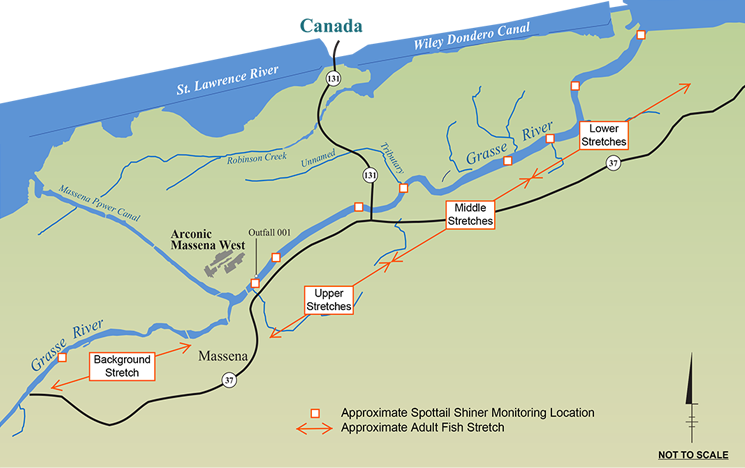Resident fish monitoring is typically performed in September or October, and consists of the collection of adult smallmouth bass and adult brown bullhead from various stretches of the lower Grasse River (grouped by Background, Upper, Middle and Lower Stretches; see map below). Adult smallmouth bass are also collected from the Massena Power Canal. These species are collected from the river because each represents a different level within the food chain; smallmouth bass are top predators that feed primarily on other fish while brown bullhead are forage fish that feed on fish, aquatics insects, worms, crustaceans and plants. Collection of common carp was also added to the program in 2015 and 2016. Fillet samples (representing the edible portion of these fish) are prepared and submitted to a laboratory for measurement of PCB levels. Since PCBs are often found in the lipids or fat of the fish, the fat content of each sample is also determined.



Young-of-year spottail shiner samples are also collected from the lower Grasse River. Spottail shiner are targeted because they have limited home ranges and relatively short life spans, making these fish good indicators of short-term changes in PCB levels in the river. Due to their size (typically about 2.5 inches in length or less), approximately 60 to 100 spottail shiner are collected from each sampling location (see map below). For each sampling location, the spottail shiner samples are divided into multiple groups of approximately 20 fish each, resulting in three to five "composite" samples for each sampling location. Each composite sample is submitted to a laboratory for measurement of PCB levels and fat content.
Over 3,600 resident fish samples have been collected as part of this monitoring program to support the design, remediation, and long-term monitoring of the project. These data are used to monitor changes in fish tissue PCB levels over time, as well as evaluate the effects of naturally occurring events (e.g., high flows, ice jams) and various in-river construction activities (e.g., pilot studies) on PCB levels in fish. (see Environmental Monitoring Results). Resident fish monitoring was pasued in 2016 due to the start of construction in 2017. The long-term monitoring program started in 2022 and includes resident fish monitoring similar to previously performed fish monitoring.

